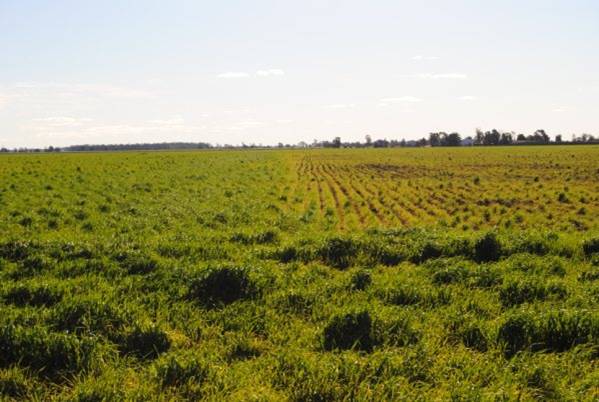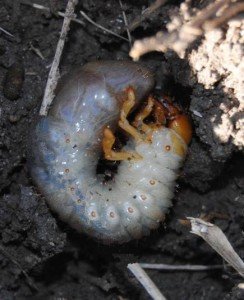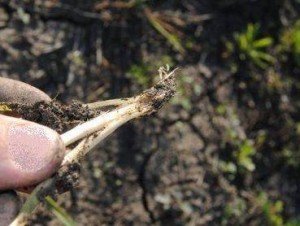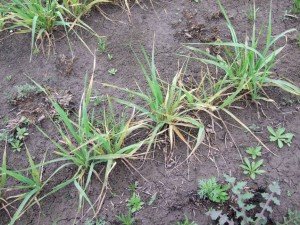This winter we’ve seen several instances of severe scarab damage to winter cereals (wheat, barley and oats) , including on crops at Jandowae and Felton on the Darling Downs. The photograph below shows that severe damage is mostly confined to areas of paddocks which were previously pasture – and this is where the highest scarab populations were found.
Scarab damage in barley crop at Jandowae. The severely damaged crop area on the right was under pasture prior to planting. The area on the left was previously cropped and cultivated.
The insect responsible for the damage is the juvenile (larval) stage of a scarab beetle. Larvae collected from one of the affected fields have been identified as most likely black soil scarab (Othnonius batesii). Larvae are currently being reared to adulthood to confirm the identity. The adults (yet to emerge) are very distinctive
Third (and final) instar black soil scarab larva (30 mm) found under damaged barley plants at Jandowae. Note the pale head capsule of this species.
Damage to crops was significant because the larvae were large from crop establishment onwards. Black soil scarabs have a 2 year larval stage. The eggs would have been laid in the pasture in spring/summer of 2009/10, and the small larvae developed whilst feeding on the roots of the pasture grasses. By autumn/winter 2010, the larvae were large (up to 30 mm), and feeding voraciously. When the pasture was removed and the winter cereal planted, the scarab larvae started feeding on the emerging cereal plants. Larvae in the field are currently estimated as 10-12 months old and at the early 3rd instar stage. They are likely to pupate in mid to late summer and emerge as adults in the spring of 2011.
The scarab larvae feed on the below-ground parts of the cereal seedlings, limiting root growth or severing roots completely. As a result, seedling cereals are moisture stressed and unthrifty.
Because scarab larvae live entirely below ground, once the crop is planted and the damage evident, there is no control option available to prevent further damage to the crop. It is simply impossible to contact the larvae with insecticide and large larve would be difficult to control even if they could be reached.
Black soil scarab adult (17 mm). Note the two-tone colour scheme – dark head and thorak, and light brown wing covers. Image by CSIRO.
Scarab damage to winter cereals is uncommon, but these cases highlight the importance of checking for soil insects prior to sowing, particularly in high risk situations such as when coming out of a pasture into a crop. Seasonal conditions (the onset of wetter than average seasons) may also have contributed to an increase in black scarab numbers.
Anyone with suspected scarab activity can contact the entomology team via this blog.
Further information on scarabs, and soil insect monitoring strategies can be found at the Queensland Government website.
Acknowledgements: Dr Peter Allsop from BSES for the identification of the scarab larvae. Steve Henning for photographs of the scarab larva and the damaged barley crop.
Article by Hugh Brier and Melina Miles






Have noted some scarab larvae in several weak patches of young sorghum this spring around Moree. Patches are approximately 25m x 25m or similar and irregular in shape. Easy to find 2-3 larvae under plants. We have experienced (too) good moisture conditions that have allowed plants to survive on minimal root structure but I expect when we experience some heat the patches will fold. One patch (in a 1000ha block of sorghum) has shown up in a series of previous crops grown there over the past 5 years and the grower recalls there being a bad patch of cooch there initially. Perhaps that has been the trigger for egg lay?
I have seen black scarab damage on particular paddocks south of Clifton. Last summer they chewed the roots off sorghum coming into head and killed out circular patches. Only known control is to cultivate the affected areas to slow their spread – the crop was dying anyway.
The black scarab beetle found on the Darling Downs are large third instar grubs which will start pupating in mid to late summer, with adults eventually emerging in spring. Therefore, affected fields will still support larvae through early summer crop establishment.
The larvae feed predominantly on roots of grasses hence sorghum is likely to be susceptible to attack by these larvae. It is less likely that broadleaf crops such as cotton will be attacked, and if scarab larvae are present in fields planted to cotton, they are likely to have a preference for grass weeds than the cotton crop.
Crops suffering root damage caused by the scarab larvae, will suffer more in dry, hot conditions where they struggle to transpire sufficiently and growth is severely retarded.
There are no registered insecticides for the control of black scarabs., and in any case post-sowing it is not possible to apply insecticide that would contact these larvae as they do not come to the soil surface. It is also unlikely that seed treatments will have an impact on the large, damaging larvae – experience in sugarcane shows that even in-furrow treatments will only control the small larvae.
It is important to note that there are many species of scarab, a large number of these are non-pest species so identification of larvae is important.
Can theses larva cause damage in cotton and sorghum as we have seen a lot of them in the cultivation where summer crop is to be planted?
Cheers Glenn